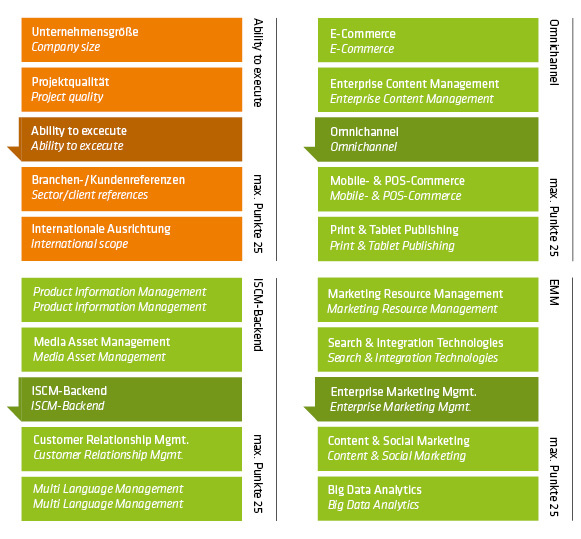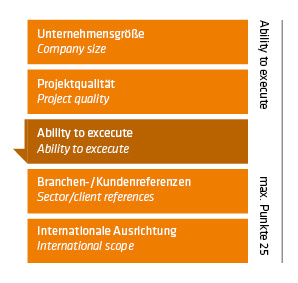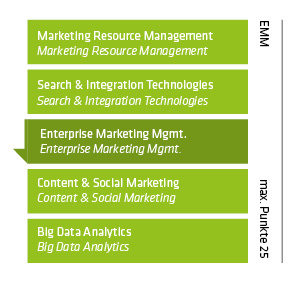Hey there,
Nice to meet you! We are The Group of Analysts. Our philosophy: Market Research Re-engineered. For you we have thrown a light on the company Netconomy regarding the MRM market. Just take a look on the left side, there you can see the Market Performance Wheel (MPW) – the result of our deep dive analysation. Besides that the following Legend will give you a great idea what every single point of information icludes. So just download the detailed MPW of Netconomy on our website www.tgoa.de
The Legend
 The Market Performance Wheel for integrators and consultants completes the MPW portfolio as it takes into account project implementation as one aspect of the selection of a solution. Often several technologies are utilised and the MPW looks at twelve sections in order to highlight the competence of each vendor at a glance. Set project requirements can thus be easily verified and successfully implemented with the appropriate partner.
The Market Performance Wheel for integrators and consultants completes the MPW portfolio as it takes into account project implementation as one aspect of the selection of a solution. Often several technologies are utilised and the MPW looks at twelve sections in order to highlight the competence of each vendor at a glance. Set project requirements can thus be easily verified and successfully implemented with the appropriate partner.
An additional focus is on the category called Ability to execute. Here, among other factors, references from clients of previous and existing projects play a vital role.
Ability to execute
 The ability to implement a project of a respective integrator is of paramount importance for a project’s success. For this reason, the evaluation of integrators has an even stronger focus on this range of requirements compared to the assessment of a manufacturer‘ s ability to execute.
The ability to implement a project of a respective integrator is of paramount importance for a project’s success. For this reason, the evaluation of integrators has an even stronger focus on this range of requirements compared to the assessment of a manufacturer‘ s ability to execute.
Evaluating company size in particular is crucial for larger enterprise projects. For this analysis, apart from the number of employees and the associated revenues for the associated project area, the company’s total size is taken into account.
As essential input in the area of project quality, differentiated results from up to ten personal customer reference interviews, in which the achievement of project objectives, the service provider performance and project satisfaction are considered, are included in the evaluation. In addition, the ability to plan and manage a project is examined next to qualifications and training of staff.
In the area of sector/client references, the vast experience of the company is highlighted. Which sectors does the integrator actively participate and have experience in. Additionally, here the overall satisfaction score of the reference interviews is included.
The analysis area of international scope shows how strongly the company positions itself as an integrator internationally. An analysis in this area assesses planned expansion projects with regards to requirements such as single and total investment or increase in personnel.
Omnichannel
The Omnichannel sector is divided into four evaluation areas. These mainly illuminate existing partnerships with manufacturers. How many solutions are listed in the respective integrator’s portfolio? If it is just one, it limits the integrator’s competence automatically. If there are many, however, one might presume the expertise offered is not profound enough. Here, mainly the number of projects carried out as well as the duration of the partnerships are indicators providing information on the actual experience. Furthermore, the complexity of completed projects may offer insights into the integrator’s know-how.
The area of E-Commerce highlights the expertise of the company in particular with regard to B2B and B2C projects, as well as taking into consideration the integration of third-party systems such as payment modules, search engines, affiliates, etc.
In the Enterprise Content Management area, basically the same questions are asked but answers are found in the analysis of the integration of other third party systems such as Translation Management, Enterprise Search and Product Information Management.
In the Mobile- & POS Commerce area, the focus is increasingly on the complexity of the respective project situations rather than on a solution used in each case, since this market is composed of more differentiated aspects. Therefore, point of sales scenarios or configure to offer / order scenarios are examined.
The Print & Tablet Publishing area again takes into account the complexity of projects from highly automated to creative, apart from looking at traditional print publishing and the solutions employed here.
ISCM-Backend
 In the Product Information Management area, the expertise in data management for product information required for Omnichannel is examined. The companies with which the integrator maintains partnerships, the duration of those partnerships, and in particular the number and complexity of projects implemented are brought to light in this evaluation.
In the Product Information Management area, the expertise in data management for product information required for Omnichannel is examined. The companies with which the integrator maintains partnerships, the duration of those partnerships, and in particular the number and complexity of projects implemented are brought to light in this evaluation.
The same applies to the area of Media Asset Management. Furthermore, through looking at other integrated and other connected systems such as E-Commerce or Enterprise Content Management and Multi Language Management, conclusions can be drawn for the complexity of projects.
The Customer Relationship Management area is considered an established market, while being a relatively new ISCM field within the consumer-centric movement at the same time. Here, the complexity of previously completed projects in particular will be reviewed and also in which industries experience has been gained already, with respect to B2B or B2C. This lays the basis for the assessment of CRM’s greater demands within the context of a comprehensive information management project.
The Multi Language Management scrutinises, in addition to technology partnerships and their duration, particularly the holistic approach: which systems have been connected? Has only one PIM or CMS system been integrated into a singular project situation to a translation memory? Is there a holistic approach to integrating a company-wide voice management and what implementation experience exists to this effect?
Enterprise Marketing Management
 The Enterprise Marketing Management is the most heterogeneous technology area in ISCM. Furthermore, Marketing Resource Management is one of the most important new areas. The assessment is based on potential systems used, the duration of the partnership as well as the complexity of the projects.
The Enterprise Marketing Management is the most heterogeneous technology area in ISCM. Furthermore, Marketing Resource Management is one of the most important new areas. The assessment is based on potential systems used, the duration of the partnership as well as the complexity of the projects.
In the area of Search & Integration Technology, the focus is on the particular technologies and standards employed. Great importance is placed on systems that have been integrated with each other.
The fledgling area of Content & Social Marketing, however, rather illuminates the integrator’s general conceptual expertise. Are the projects more marketing and advertising driven with a low level of integration and manageable complexity? Or, is there a holistic approach to the integration of content and social marketing and have respective projects been implemented already?
The Big Data Analytics area again includes the systems utilised and the project’s complexity in the assessment, but places the focus on scenarios relevant to product and consumers while other Big Data scenarios remain largely unobserved.
Get the entire MPW with all its detailed figures on the respective groups of information on www.tgoa.de
For more information about the analysed software integrator visit www.netconomy.net